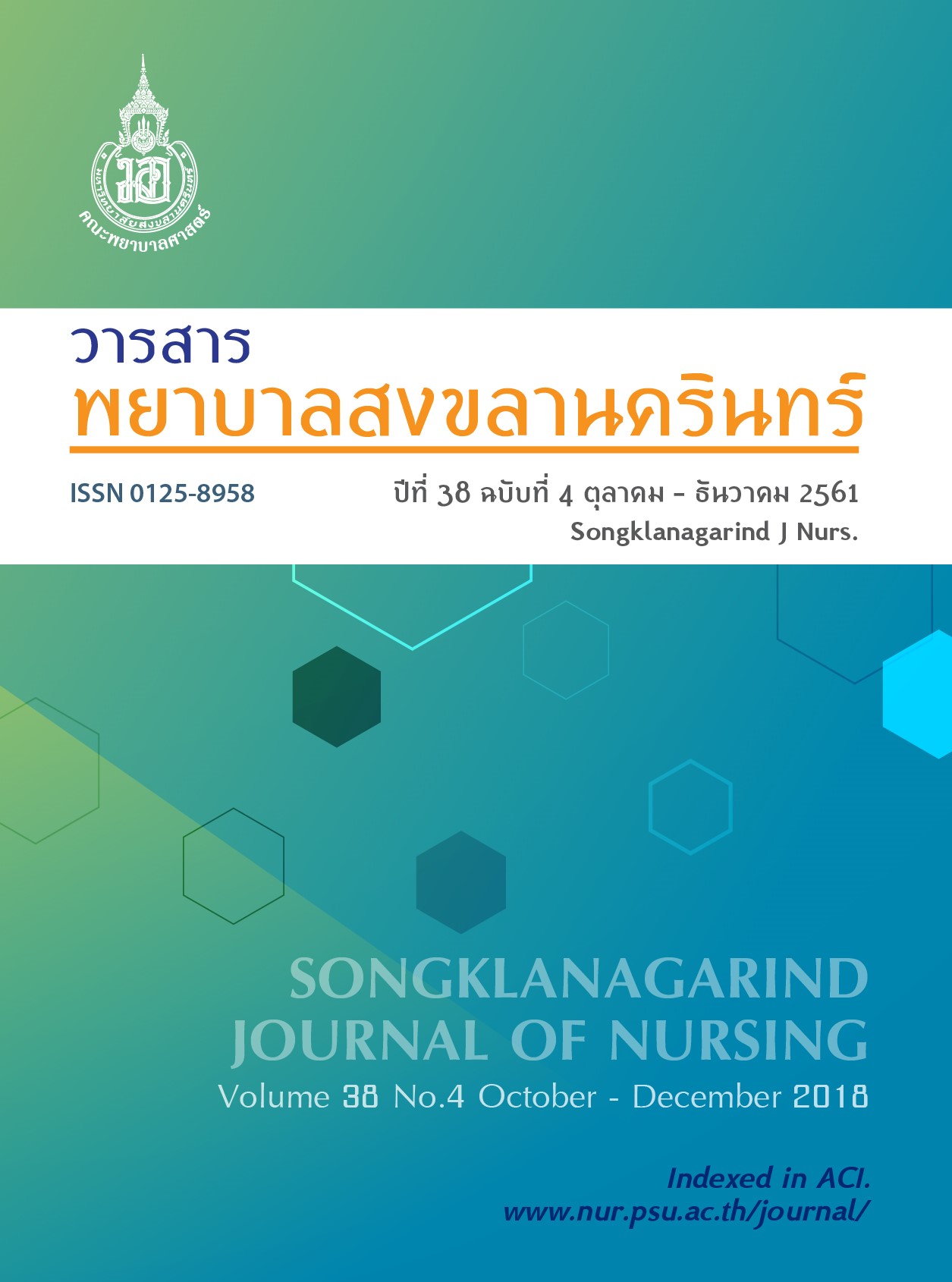Caring Behaviors in Providing Care for End of Life Patients of Nursing Students and Novice Nurses, Thammasat University
Main Article Content
Abstract
This descriptive study aimed to compare caring behaviors of fourth year nursing students and novice nurses. The participants included 81 fourth year nursing students and 56 novice nurses from Faculty of Nursing, Thammasat University. The instruments for collecting data were: 1) The demographic data form, and 2) The Nurse’s Caring Behavior for Dying Patients Questionnaire which had a test-retest reliability of 0.97. Data were analyzed using Mann-Whitney U test. The results showed that novice nurses had overall caring behaviors and each component of caring behavior statistically higher than that of fourth year nursing students (p <.001). However, for items related to providing time for end-of-life patients and their families, the fourth year nursing students had higher score than novice nurses. The findings of this study can be used for teaching and learning development in order to continue cultivating caring behavior for nursing students.
Article Details
References
2. Hui D, Nooruddin Z, Didwaniya N, et al. Concepts and definitions for “actively dying,” “end of life,” “terminally ill,” “terminal care,” and “transition of care”: a systematic review. J Pain Symptom Manage. 2014; 47: 77-89.
3. Nilmanat K. The end of life care. Songkla: Chanmuang Press; 2012. Thai
4. Mithrason AT, Parasuraman G, Lyer RH, et al. Psychosocial problems and needs of patients in palliative care center. Int J Community Med Public Health. 2018; 5(4): 1385-1391.
5. Connor SR, Bermedo MC. Global atlas of palliative care at the end of life [Internet]. Geneva: Wold palliative care alliance; 2014 [Cited 2018 Sep 20]. Available from: http://www.who.int/nmh/Global_Atlas_of_Palliative_Care.pdf
6. Kosolchuenvijit J. Caring: Central focus of humanistic care. Journal of Boromarajonani College of Nursing, Bangkok. 2013; 29: 134-141. Thai
7. Roach MS. Caring, The human mode of being: A blueprint for the health professionals. 2 nd ed. Canada: CH Press; 2002.
8. Kongsuwan W, Prompahakul C. Caring in nursing persons at the end of life. In: Nilmanat K and Kongsuwan W, editor. Common Phenomena in the End-of-life Stage and Caring. Songkhla: Joy Print; 2013. Thai
9. Sririlai S. Ethics for nurses. Bangkok: Chulalongkorn University Printing House; 2010. Thai.
10. Akarathanarak T, Kongsuwan W, Matchim Y. New registered nurses’ knowledge in caring for patients at the end of life. Songklanagarind Journal of Nursing. 2014; 32(2): 103-116. Thai.
11. Lloyd-Williams M, Field D. Are undergraduate nurses taught palliative care during their training?. Nurse Education Today. 2002; 22: 589-592.
12. Johnson A, Chang E, O’Brien L. Nursing the dying: A descriptive survey of Australian undergraduate nursing curricula. International Journal of Nursing Practice. 2009; 15: 417-425.
13. Gillan PC, Parmenter G, van der Riet PJ, et al. The experience of end of life care simulation at a rural Australian University. Nurse Education Today. 2013; 33: 1435-1439.
14. Nurse.tu.ac.th. [homepage on the internet]. Bangkok: Undergraduate cirricurum, Faculty of Nursing Thammasat University [updated 19 Sep 2018; cited 2018 Sep 20]. Available from: http://www.nurse.tu.ac.th/th/public/degree/bachelor/curriculum
15. Akarathanarak T, Kongsuwan W, Matchim Y. Relationship between preparedness and caring behavior for patients at the end of life among novice nurses. Journal of Public Health Nursing. 2017; 31: 160-174. Thai
16. Panuraj S. The factors related to nurses’ caring behaviors in providing care for end-oflife patients. [master’s thesis]. [Pathumthani]: Thammasat University; 2017. 163 p.
17. Yamane T. Statistics, An Introductory Analysis. 2 nd ed. New York: Harper and Row; 1967.
18. Prompahakul C, Nilmanat K, Kongsuwan W. Nurses’ caring behaviors for dying patients in Southern Thailand. Nurse Media Journal of Nursing. 2011; 1: 147-158.
19. Thai Nursing Division. Guideline for nursing practice based on ethics of nursing profession (revised version). Nonthaburi: Ministry of Public Health; 2008 [Cited 2018 Sep 20]. Availablefrom: http://www.nursing.go.th/Book_nurse/Approachtostaffing / Approachtostaffing.pdf
20. Matchim Y, Raetong P. Thai nursing students’ experiences of caring for patients at the end of life: A phenomenological study. Int J Palliatve Nurs. 2018; 24: 220-229. doi: 10.12968/ijpn.2018.24.5.220.
21. Tamarpirat N, Oumtanee A. Being a newly graduated nurse working under supervision of a mentor. Journal of The Royal Thai Army Nurses. 2017; 18: 32-40. Thai.

